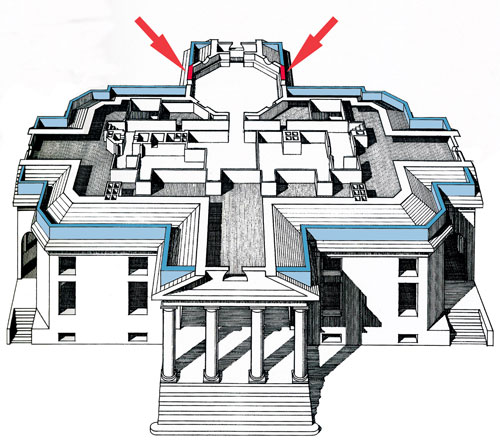Now I'll share one of my favorite details from Monticello, a clever solution to a problem that would have eaten away at our third president's perfect vision.
Jefferson wanted a balustrade to go completely around the roof line of the house. I've shown that by color coding it blue. The problem is that the balustrade would be interrupted as it met the exterior wall of the dome (shown in red).
Jefferson's solution was to have a very thin, flat balustrade affixed to the side of the dome, so that there would be an optical continuity.
And from the ground level, it works perfectly. Incidentally, Jefferson was an avid billiards player, and the dome originally housed a billiards table. Unfortunately for Jefferson, Virginia outlawed billiards, and the dome fell into disuse. Susan R. Stein, author of The Worlds of Thomas Jefferson at Monticello, writes of Margaret Bayard Smith's impression of the dome, when Smith visited Monticello in 1809:
'[Jefferson] afterwards took us to the drawing room, 26 or 7 feet diameter, in the dome. It is a noble and beautiful apartment, with eight circular windows and a sky-light. It was not furnished and being in the attic story is not used, which I thought a great pity as it might be made the most beautiful room in the house."
The image of the dome interior is from the Thomas Jefferson Memorial Foundation.
All other images are from Jefferson's Monticello, William Howard Adams, 1983.
Photography by Langdon Clay.





No comments:
Post a Comment